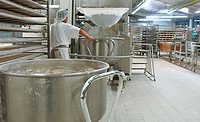Study Identifies Biofilm-Forming, Drug-Resistant Pseudomonas Strains Posing a Challenge to Dairy Industry

Image credit: azerbaijan-stockers via Freepik
A recent study of Pseudomonas spoilage microorganisms isolated from dairy products in Spain identified the presence of highly biofilm-forming, antibiotic-resistant strains, presenting challenges for dairy industry control strategies. The researchers caution that these traits, which are especially pronounced in the P. fluorescens subgroup, could facilitate the transfer of antimicrobial resistance (AMR) genes to pathogenic foodborne bacteria.
Published in Foods, the project was carried out by Department of Food Technology researchers from the Spanish National Research Council’s Institute of Agricultural and Food Research and Technology (CSIC’s INIA). The researchers isolated, identified, and cultured 106 Pseudomonas strains from Spanish cheese whey, raw and pasteurized milk, and spoiled creams and cheeses. Of the 20 identified species, P. fluorescens (19 percent), P. fragi (16 percent), and P. lundensis (12 percent) were the most prevalent; the species were further classified into strains.
The biofilm-forming ability of the Pseudomonas strains was tested at 6 °C and 25 °C, representing refrigeration and ambient temperatures, respectively. Biofilm production was strongly influenced by temperature, with higher formation observed under refrigeration. After 48 hours of incubation, 72 percent and 65 percent of strains formed biofilms at 6 °C and 25 °C, respectively. At 6 °C, 80 percent of the biofilm-forming strains were classified as high producers, and at 25 °C, 39 percent of the biofilm formers were classified as high producers.
Strains of P. shahriarae, P. atacamensis, P. salmasensis, and P. canadensis were identified as high biofilm producers, alongside well-known dairy Pseudomonas such as P. fluorescens, P. koreensis, and P. lundensis. On the other hand, most P. fragi and P. putida strains exhibited low or no biofilm-forming ability. The researchers also tested the Pseudomonas for the adnA gene, and found that it played an important role in biofilm formation among certain species including P. fluorescens, P. shahriarae, P. salmasensis, and P. canadensis.
Antimicrobial susceptibility of the Pseudomonas strains to 14 antibiotics was also tested, following the European Committee on Antimicrobial Susceptibility Testing (EUCAST) guidelines. While most strains showed susceptibility or sensitivity to a range of antibiotics (i.e., aminoglycosides, 2- and 4-Quinolones, penicillins and beta-lactamase inhibitors, and cephalosporins), variable sensitivity was observed for the carbapenem meropenem, with 66 percent of strains fully susceptible and 13 percent of strains resistant. The majority of P. fragi (82 percent), P. lundensis (69 percent), P. weihenstephanensis (100 percent), and Pseudomonas spp. strains from the P. fragi subgroup (67 percent) were sensitive to all antibiotics.
However, 73 percent of Pseudomonas strains were resistant to the monobactam aztreonam. The researchers also found not-insignificant levels of resistance to carbapenems imipenem (28 percent of strains), doripenem (28 percent), and meropenem (13 percent), as well as cephalosporins ceftazidime (19 percent) and cefepime (7 percent). Additionally, several strains showed multidrug resistance (MDR); 78 percent of P. fluorescens and 100 percent of P. shahriarae were resistant to two or more antibiotic classes.
A total of 15 strains were resistant to three or more drug classes, and three strains were resistant to four classes. Specifically, 85 percent of P. shahriarae, 21 percent of P. fluorescens, and 30 percent of Pseudomonas spp. strains from the P. fluorescens subgroup were identified as MDR.
Overall, the researchers underline that the presence of biofilm-forming, AMR Pseudomonas strains, especially within the P. fluorescens group, could pose significant challenges for dairy industry control strategies. These biofilm-forming and resistance traits could facilitate the transfer of AMR genes to pathogenic bacteria during processing or after dairy product consumption.
Looking for a reprint of this article?
From high-res PDFs to custom plaques, order your copy today!






